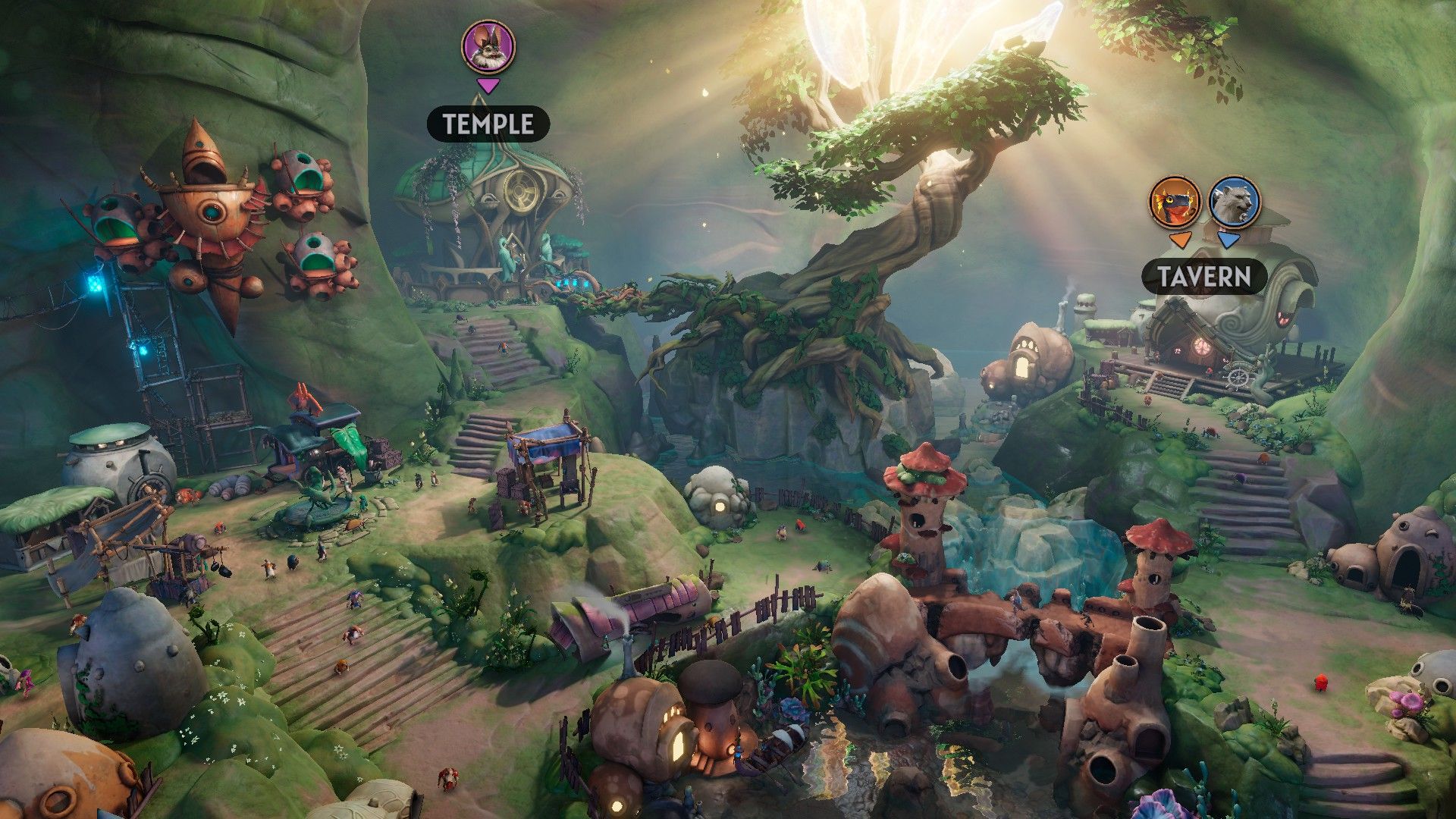The intersection of tabletop and digital experiences has always fascinated developers and players alike. Enter Sunderfolk, a bold new venture from Secret Door—a studio founded by former Blizzard employees under the umbrella of Dreamhaven. This ambitious project seeks to bridge the gap between physical tabletop role-playing games (TTRPGs) and their digital counterparts, creating a hybrid experience that feels both nostalgic and refreshingly modern. And remarkably, Sunderfolk succeeds in delivering on its lofty ambitions.
A Virtual Tabletop Experience
At its core, Sunderfolk is designed to mimic the essence of a traditional tabletop RPG campaign. Players gather around a virtual table, each armed with a smartphone or tablet, while the main screen displays the game world. Unlike many digital games, Sunderfolk leverages multiple devices to create an immersive, collaborative atmosphere. The primary screen serves as the central hub, displaying maps, enemies, and other dynamic elements, while secondary screens on players’ phones allow for personalized interactions and decision-making.
This dual-screen setup is巧妙地 executed, eliminating the need for clunky controllers or complicated setups. Upon launching the game on Steam, for instance, players are greeted with a QR code that directs them to the Sunderfolk app. Scanning the code grants instant access to the game, streamlining the process and ensuring a seamless start. This simplicity is a testament to the developers’ focus on user experience, a hallmark of Blizzard alumni.
Character Creation and World-Building
One of Sunderfolk’s standout features is its character creation system. Players choose from a diverse cast of anthropomorphic warriors, each with unique abilities and personalities. From the towering Berserker Bear-Serker to the cunning Pyromancer and stealthy Ranger, the roster caters to various playstyles. Each character is meticulously designed, reminiscent of beloved fantasy literature like Redwall . Their archetypes are immediately recognizable, making it easy for newcomers to dive in without feeling overwhelmed.
But Sunderfolk doesn’t stop at basic customization. Players have the freedom to craft their characters’ names, backgrounds, and even quirks. During one session, I renamed healing shrines “Butt,” while another player labeled an enemy class “Zoomers”—a moniker that stuck throughout our campaign. These playful touches underscore the game’s commitment to fostering creativity and personalization. The developers clearly understand that a sense of ownership enhances immersion, encouraging players to invest in their characters and the world around them.
Beyond renaming, Sunderfolk rewards players with nuggets of lore and world-building delivered directly to their second screens. Whether it’s a cryptic hint or a humorous aside, these snippets enrich the narrative and deepen engagement. For example, visiting the tavern reveals amusing details like “Baja Blast” on the menu or the Oracle’s boat renamed “Rocinante.” Such touches add depth to the world, making each player feel like a co-author in shaping the unfolding story.

Smooth Interplay Between Screens
The seamless integration of the main and secondary screens is a testament to Sunderfolk’s technical prowess. During downtime in the game, players engage in conversations with townsfolk, building relationships and making dialogue choices—all on their individual phones. This decentralized approach ensures that each player has their own moment to shine, preventing the game from becoming a passive spectator sport. Meanwhile, the main screen displays character icons hopping around as everyone contributes to their respective side stories.
Combat sequences are equally impressive. Turn-based battles unfold on the main screen, while players use their mobile devices to move a cursor and select actions. Controls are intuitive, allowing players to swiftly navigate menus, access abilities, and manage resources. The ability to swap out Fate Cards—drawn randomly from a deck—adds an element of unpredictability, keeping every encounter fresh. Drawing a “Blue” card might boost an attack’s damage, while a “Red” card could introduce a drawback, forcing players to adapt mid-battle.
This dynamic interplay between screens fosters teamwork and communication. Players must strategize together, discussing tactics and coordinating attacks. For instance, one mission required us to reactivate “mine carts”—giant beetles whose tracks surged forward, crushing anything in their path. By strategically placing enemies on the tracks, we turned these creatures into lethal weapons, turning the tide of battle. Such inventive scenarios demonstrate Sunderfolk’s ability to craft engaging, memorable encounters.
Strategic Depth and Deck-Building
While Sunderfolk excels in its storytelling and gameplay mechanics, its true brilliance lies in its strategic depth. Unlike traditional TTRPGs, which rely on dice rolls, Sunderfolk employs Fate Cards to determine outcomes. Each player starts with a 10-card deck consisting of three Blue (positive), three Red (negative), and four Black (neutral) cards. These cards dictate the success or failure of actions, adding a layer of randomness that keeps players on their toes.
Over time, players can expand their decks by acquiring new cards, creating a deck-building mechanic that rewards experimentation and optimization. For example, I discovered that my Berserker’s bone hammer dealt weakened blows when I drew low-value cards. Initially frustrating, this mechanic transformed into a strategic advantage as I accumulated cards with beneficial side effects. Drawing a Red card might deal less damage but heal me simultaneously, or inflict area-of-effect damage. By carefully curating my deck, I turned these drawbacks into strengths, enhancing my character’s resilience and effectiveness.
This balance between chance and strategy ensures that no two playthroughs are identical. Players must constantly evaluate their options, weighing the risks and rewards of each action. Whether it’s deciding whether to take a risky shot or conserve resources for a future encounter, Sunderfolk demands thoughtful decision-making. This layer of complexity elevates the experience beyond mere button-mashing, rewarding players who invest time and effort into mastering their characters.
Collaborative Gameplay and Social Dynamics
Sunderfolk thrives on collaboration, emphasizing teamwork and communication. While solo play is possible, the game truly shines when played with a group. Sitting around a virtual table, players discuss strategies, share resources, and celebrate victories together. This communal aspect fosters camaraderie, much like a traditional tabletop RPG session. Even in situations where one player couldn’t join, piloting multiple characters felt cumbersome and less enjoyable, highlighting the importance of having a full team.
However, Sunderfolk does present some challenges when it comes to catching up. Late joiners often miss out on valuable loot and mission-specific rewards, which can create an imbalance within the group. While leveling systems help bridge the gap, some players may feel disadvantaged if they join midway through an act. Addressing this issue could involve implementing more forgiving catch-up mechanisms, ensuring that all players remain engaged and motivated.
Despite these minor hiccups, Sunderfolk’s collaborative spirit shines brightly. The game’s pacing is deliberately balanced, alternating between intense combat encounters and relaxed downtime. After completing a mission, players return to the town to upgrade gear, forge relationships, and prepare for the next adventure. This rhythm keeps the experience engaging without becoming overwhelming, allowing players to recharge between sessions.
The Power of Voice Acting
Another standout element of Sunderfolk is its voice acting. Actress Anjali Bhimani lends her talents to the role of the Game Master (GM), voicing every character with charm and nuance. Her performance imbues the game with personality and depth, making each encounter feel more personal and engaging. Bhimani’s portrayal elevates Sunderfolk beyond a mere digital game, transforming it into a rich, immersive narrative experience. Her contributions are reminiscent of Amelia Tyler’s work in Baldur’s Gate 3 , further cementing Sunderfolk’s credentials as a worthy successor to classic TTRPGs.
Sunderfolk represents a significant leap forward in the realm of digital board games. By blending the flexibility of a digital space with the intimacy of a tabletop RPG, Secret Door has created a hybrid experience that feels authentic and enjoyable. Its dual-screen design, strategic depth, and collaborative gameplay mechanics make it an ideal choice for groups looking to recreate the magic of a traditional game night in a virtual setting.
While Sunderfolk isn’t without its flaws—catch-up mechanisms and occasional technical hiccups being notable areas for improvement—it more than compensates with its innovative approach and engaging content. Aspiring to be your next game night staple, Sunderfolk succeeds in delivering a memorable, cooperative experience that bridges generations of gamers. With its April 23 release date fast approaching, Sunderfolk stands poised to captivate audiences across platforms, proving that the digital board game genre still has untapped potential.
For those seeking a fresh take on cooperative gaming, Sunderfolk is a must-play. Whether you’re a seasoned TTRPG enthusiast or a casual gamer looking for something new, this title offers something for everyone. So gather your friends, grab your phones, and embark on an unforgettable journey through the enchanted lands of Sunderfolk.
















Add Comment